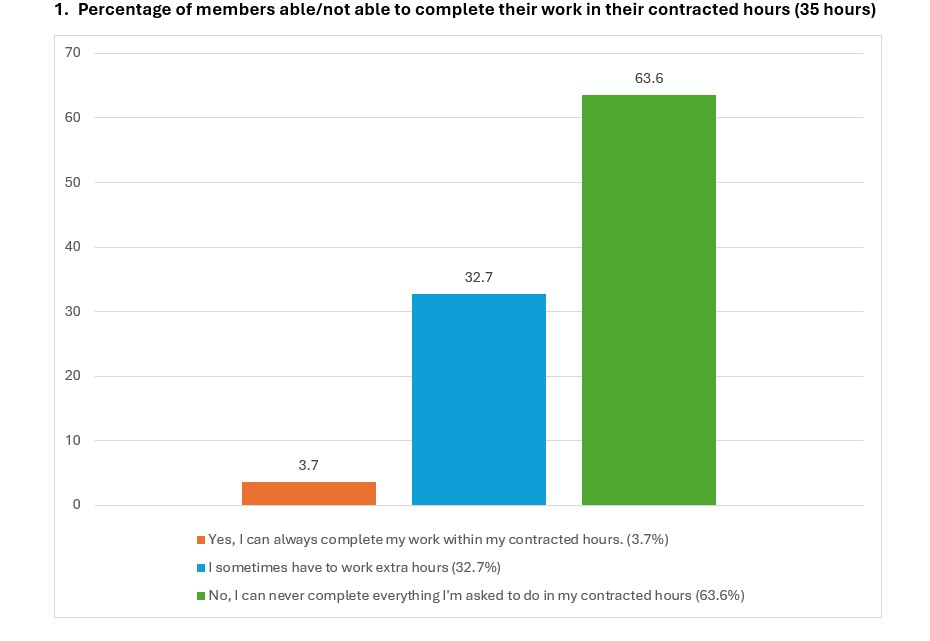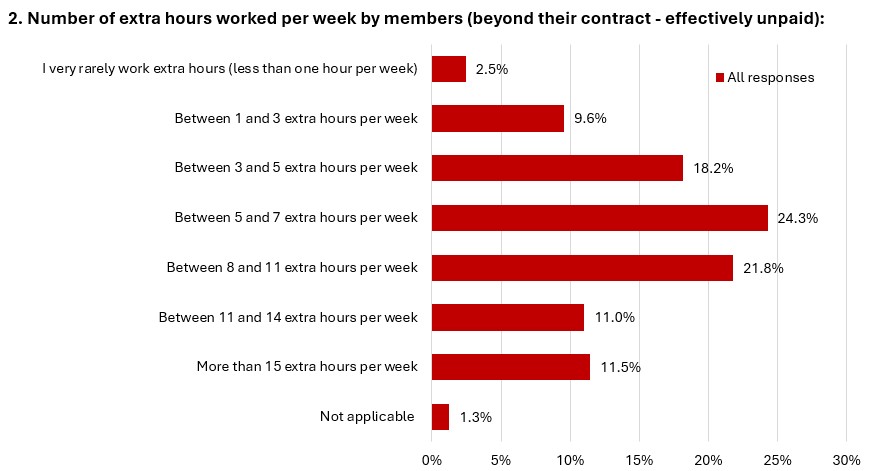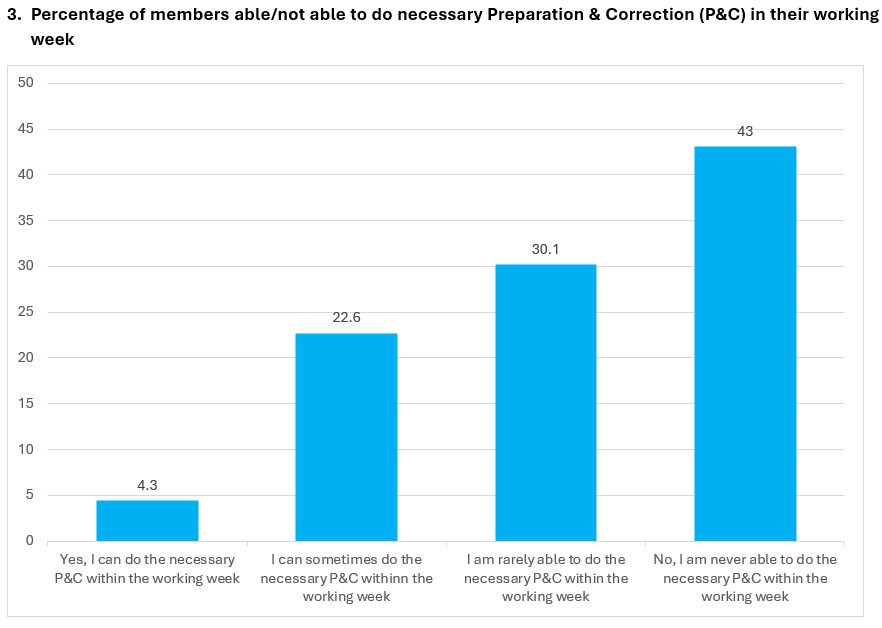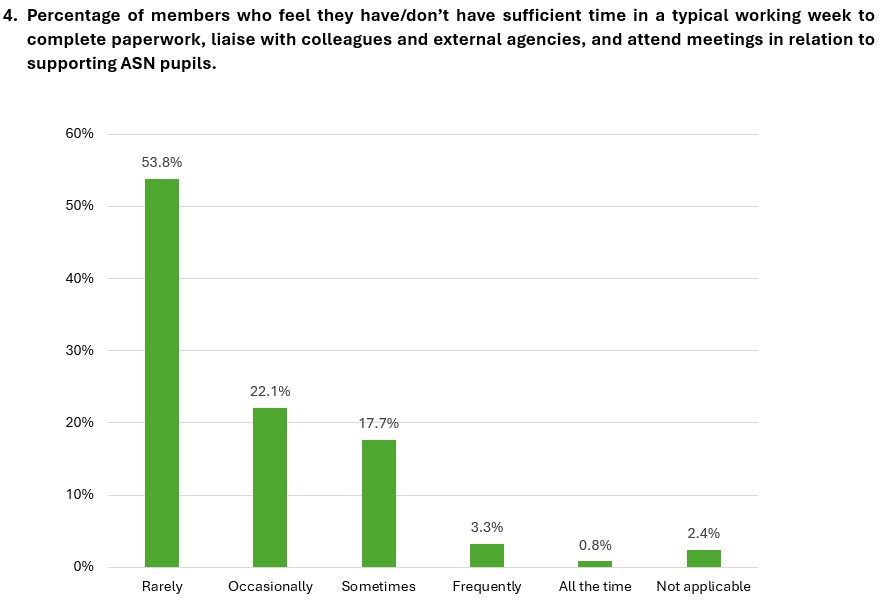Created on: 27 May 2025 | Last modified: 02 Jun 2025
The EIS Stand Up for Quality Education (SU4QE) campaign acknowledges that the current workload of teachers is excessive and unsustainable, and needs to be addressed urgently.
SU4QE aims to bring teacher workload to a level manageable within the 35-hour working week - in the interest of fair work, to reduce stress and improve the health and wellbeing of our members. Our SU4QE Campaign’s workload element has four aims:
Local Wins
We have made progress at Local Authority (LA) and school levels by successfully campaigning locally for more teacher empowerment, no redundancies, protecting education services (e.g, IMT) and more education funding at Council level. We have produced advice on mitigating workload, eliminating unnecessary bureaucracy and WTAs.
National Wins
In principle, at least, the Scottish Government has adopted the empowered teacher within an empowered school system, has made supportive public statements on reducing bureaucracy, and has made efforts to ensure that Local Authorities protect teacher workforce numbers.
Our campaigning led to the SNP partially adopting our policy aim of 20 weekly contact hours in its 2021 Scottish Parliamentary Election Manifesto; “We will recruit at least 3,500 additional teachers and classroom assistants and reduce daily contact time by an hour and a half per week”
Also, “We will build up the resilience of our education system giving teachers more time out of the classroom to prepare for lessons, undertake professional development and tackle the challenges of closing the attainment gap.”
The SNP was elected to power as the current Scottish Government on this manifesto. The Scottish Government has not prioritised its work or spending to deliver this manifesto promise of reducing class contact to 21 hours per week, and the EIS is campaigning in order to persuade the Scottish Government to do so.
We already know that our members work on average an extra 11 hours per week in addition to their 35 hour weekly contracted hours according to independent research we facilitated last year. Our National Members’ Survey (2025) had over 10,000 responses – and it gives us an accurate snapshot of members’ experiences in 2025.
The key findings are summarised in the following five graphics:




5. Top Four Workload Drivers Identified by Members (members identified their top 3 drivers hence responses are over 100% when combined)
|
Workload drivers |
% of respondents that identified the listed workload drivers |
|
Completing paperwork/admin/bureaucracy |
74.9% |
|
Managing the behaviour of students |
70.2% |
|
Tracking and monitoring activities |
67.4% |
|
Responding to management requests |
49.1% |
In essence, the National Survey shows members are:
The National Survey’s findings also show that that Local Authorities’ staffing and professional support services have not kept up with rising demand, especially ASN, and highlight workload intensification driven by increasing expectations on teachers and insufficient resources (especially time) in schools.
According to work jointly published by the World Health Organisation (WHO) and International Labour Organisation (ILO) and previously published work in the Lancet, working long hours is now known to be responsible for about one-third of the total estimated work-related burden of disease, it is established as the risk factor with the largest occupational disease burden.
The study concludes that working 55 or more hours per week is associated with an estimated 35% higher risk of a stroke and a 17% higher risk of dying from ischemic heart disease, compared to working 35-40 hours a week. Put simply, the more hours you work the more likely you are to have a stroke or heart disease.
It should be noted that the National Survey 2025 showed that over 10% of members are working more than 48 hours a week which is the legal maximum number of working hours (on average) under the UK’s Working Time Regulations.
The EIS regards delivering 21 hours weekly class contact as promised by the Scottish Government as a welcome step in the direction of reducing workload and delivering our aim of 20 hours weekly class contact for all teachers. The Manifesto promise to the electorate should be honoured.
However, simply having a maximum of 21 hours of class contact per week may not meaningfully help teachers if the 1.5 hours released results in additional time for collegiate/whole school activity and tasks that must be negotiated between teachers and school management. The evidence is clear that teachers urgently need an increase in Preparation & Correction time, as opposed to any increase in Collegiate time. The EIS is clear that the 1.5 hours of weekly time gained must be in teachers’ control as part of your Preparation and Correction time, otherwise it is highly likely to lead to an increase in workload rather than a reduction.
Reducing weekly class contact to 21 hours with the gained time added to preparation and correction time, provides members with five clear gains:
The OECD’s Education at a Glance 2024 report finds that the OECD annual averages for class-contact time (i.e. teaching hours) across the primary sector is 773 hours and the secondary sector is 679 hours. In Scotland, with our 22.5 weekly class contact the annual figure for both sectors is 855 hours.
For 2023, only Costa Rica, Chile and Peru’s teachers have higher class contact than Scotland.
Furthermore, the proportion of working time spent teaching is also recorded and analysed by the OECD.
It records that:
At the upper secondary level, teachers spend 43% of their working time on teaching on average, ranging from less than 32% in Japan, Norway and the Republic of Türkiye, to 61% or more in Luxembourg, Peru and Scotland (United Kingdom).
Scotland’s secondary teachers have the OECD’s joint lowest proportion of Preparation & Correction time for their teaching hours, with teachers in some OCED countries having twice as much Preparation & Correction time per teaching hour than Scotland.
Scottish teachers teach so much that they have little time to carry out the associated out-of-class work.
In 2024, we facilitated independent research by a team of academics to investigate teacher workload in Scotland. It found that:
Teacher workload is unsustainable; our national survey (2025) reinforces this and shows teacher stress rates increasing – almost 1 in 3 teachers have sought help from their GP for stress according to the national survey. We recognise that 1.5 hours is a difficult timetable unit of time, and that there is sometimes extra work in sharing your teaching collaboratively with other teachers.
Workload was cited in our survey as the most common reason for those leaving the profession. Teachers cannot continue to sacrifice their health in order to minimise potential short-term disruption/change to some classes.
We also have qualified teachers who have no jobs or who are on temporary contracts who can undertake this extra teaching on a permanent basis.
We recognise that 1.5 hours weekly less teaching will not solve all workload problems – but it will improve workload for teachers. This is a positive step for all.
|
Weekly Class Contact |
Preparation & Correction |
|
|
Current SNCT |
22.5 hours |
7.5 hours |
|
EIS workload aim reflecting SNP Manifesto commitment |
21 hours |
9 hours* |
*The SNP Manifesto implies more ‘Preparation & Correction’ time by stating “giving teachers more time out of the classroom to prepare for lessons..” COSLA wishes to use the gained time to be put into collegiate time. The EIS is clear that the whole 90 minutes goes to Preparation & Correction time.
Extra teachers to deliver a reduction in weekly class contact would mitigate workloads for all teachers. Where there are falling pupils rolls in some schools, reduced weekly class contact could also protect teachers’ jobs.
Of course, teachers enjoy their teaching contact with pupils, and some may prefer to change other things to reduce workload instead of reducing class contact. At the moment, there is no other significant opportunity to reduce teacher workload.
We are not going to let the Scottish Government renege on its Promise of 1.5 Hours Less Weekly Contact
It is wrong for a political party to be elected on a promise of action that it then fails to implement.
Without our ongoing pressure, the Scottish Government may not deliver its manifesto promise as it ditched a previous manifesto commitment to reduce P1-3 class sizes to 18 pupils each after the 2007 election. We cannot let this happen again.
We have campaigned strenuously to persuade the Scottish Government to deliver on its 2021 Manifesto promise – we have arranged members’ emails, MSPs briefings, online petitions, meetings with Scottish Government Ministers, SNCT negotiations, etc – nothing has yet got us a cast iron guarantee that the Scottish Government will facilitate delivery of the 1.5 hours weekly class contact reduction with this 1.5 hours to be used for teachers’ preparation and correction.
Finally, in February 2025, we lodged a dispute at the SNCT on delivering the weekly class contact reduction. Now we are moving to a consultative ballot for industrial action to pursue that dispute. The greater the turnout and the greater the support for industrial action then the greater the pressure on the Scottish Government to act.
Our consultative ballot will open June 6th and close on August 28th. We are not rushing into industrial action, but there seems to be no other way to persuade the Scottish Government to deliver on its promise.